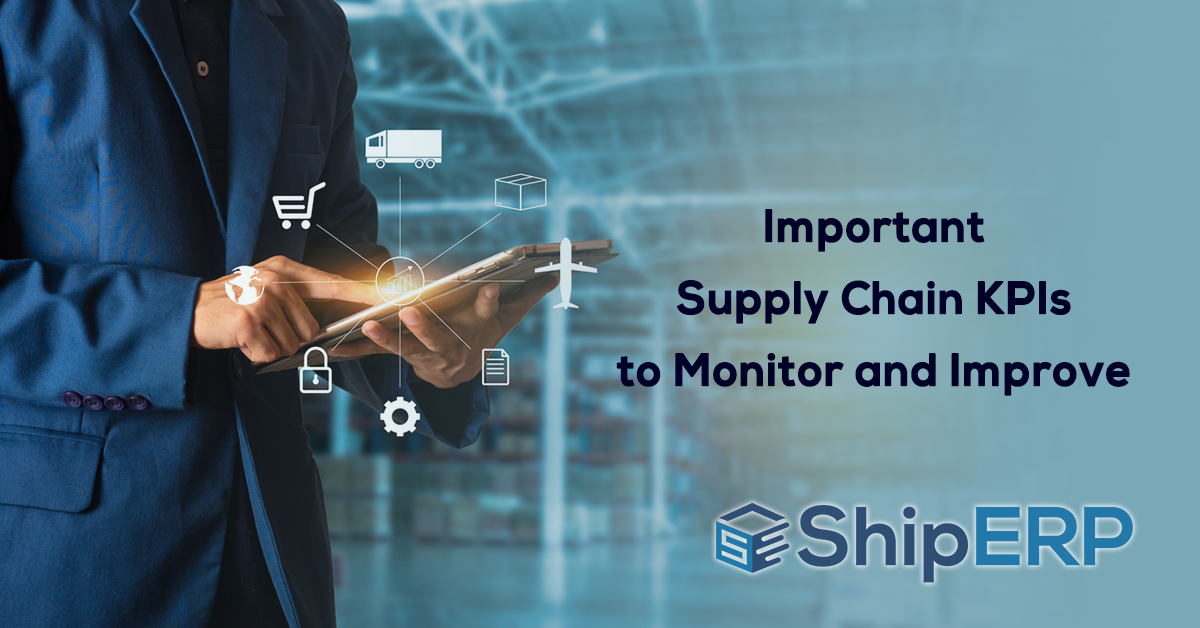
Important Supply Chain KPIs to Monitor and Improve
Your supply chain is the lifeblood of your business. You need to maintain a steady flow to keep all systems healthy and continually track key performance indicators (KPIs) to identify areas of improvement.
Supply Chain KPIs, essentially, are metrics that tell you how well you are doing in certain areas of your business. For supply chain professionals, these include:
- Freight cost savings
- Distribution efficiency and accuracy
- Volume and quantity of shipments
- Development and maintenance costs
Staying on top of these KPIs will help you stay on course, driving the necessary corrections to keep your operation running smoothly. These are cross-functional—the metrics contribute to the success of other KPIs and the performance of the entire supply chain.
Keep in mind that there are many more metrics you can be tracking. Here, we’re just going to talk about the four shipping KPIs, how to do it, and how ShipERP can help via their consulting and shipping software.

Tracking Supply Chain KPIs: How to Do It and Why It’s Important
Your KPIs need to be specific, measurable, and relevant to your daily business. They should be easy enough to understand at-a-glance, meaning it shouldn’t have to take a data scientist to decipher them.
The bottom line: have access to an actionable data set that delivers simple, vital information.
Start With A Benchmark
You will need to start with a benchmark to measure your results against. That way, if there is any measurable fluctuation, you will know immediately that something is not quite right.
When you see a KPI consistently exceeding your expectations, then you can raise the bar and strive for an even higher standard. This is where excellence happens; when you align your KPIs with your business objectives, business growth is assured.
So, let’s get down to it. What are the KPIs, and how can you make them work for you?
1. Freight cost savings
With today’s complex logistics networks, multi-carrier routes, less-than-load, and all of the various shipping methods available, it’s easy to get hung up on the status quo. However, to remain competitive and stay in the black, it’s crucial to access the most cost-effective freight methods for the load you are shipping. Otherwise, you risk sacrificing your margin simply because “we’ve always done things this way.”
Your logistics team should always look for for the best possible option, both in terms of cost, quality, and suitability (for the materials being shipped). Furthermore, your shipping solution should provide you with real-time carrier rate quotes so that you can find the best value.
2. Distribution efficiency and accuracy
If accuracy is the key to keeping your customers happy, keeping things running at peak efficiency on your end is the core principle. This means being able to track incoming and outgoing shipments with ease, knowing exactly where your loads are and what their status is at any given time.
In today’s cutthroat business economy, even a small delay can have a massive impact on the bottom line. By leveraging the right tools and compliance support, you can deliver the accuracy and efficiency your customers demand and also reduce the time you spend on things like chasing lost shipments or managing your fleet.
ShipERP is the SAP-enabled suite of software that gives you everything you need to ensure your efficiency, compliance, and shipment accuracy. With sales order integration, address validation, hazardous materials module, and more, you hold all the cards. Incidents are monitored in real-time to help you respond immediately and continue to improve.
3. Volume and quantity of shipments
Measuring the volume and quantity of shipments that leave your warehouse will provide you with insights into your busy seasons and rush hours. This allows you to budget your time and resources adequately. Coming up short at the holidays, for example, wouldn’t be good for business. However, it’s not enough to simply know that it’s going to be busier around that time. You need to know how much busier so you can plan your shipments with accuracy.
Knowing these key metrics allows you to strike a balance between income and outcome, helping you preserve your margins and have better oversight on the variables that affect them.
4. Development and maintenance costs
The costs of managing your warehousing facility can be easily overlooked. However, you should keep in mind that the level of efficiency in your organization has a direct correlation to your bottom line. The more efficient your people, machines, and systems are, the more predictable the results. This will translate to greater value through every process.
Maintenance KPIs help you identify the cause of machine failure and gain a better understanding of what processes are responsible for production losses. They can also lend insight into how well your maintenance programs are working.
Some of the KPIs you can track include:
- Equipment reliability
- Maintenance quality
- How quickly your crew responds
- Cost of maintenance
These metrics will also help you predict failure by comparing the volume of emergency work over a period of time versus planned work and compliance.

Supply Chain Metrics/KPIs: Best Practices
KPIs should give you the data you need to gain enough insight to improve processes. They should give you a good indication of what’s working and what isn’t, but they shouldn’t take too many resources away from critical functions to do so.
Here are some tips for choosing KPIs to track:
- Choose as few KPIs as possible.
- There should be enough to get a good idea of what’s going on, but not so many that it takes vital resources away from operations.
- Keep in mind that if it can’t be measured and quantified, it’s not a KPI.
- The insights you gain should ideally improve your operations or, at the very least, encourage positive behaviors.
- Take that into account that some KPIs can be influenced by outside sources.
- Choose KPIs based on how they support your business strategy.
- Set benchmark values based on average performance. Don’t set the bar too high in the beginning or you’ll be chasing an unattainable objective.
- Establish collection and measurement processes for each KPI. This could be software-driven, manual, or automated, for example, data collected from IoT devices.
How ShipERP Can Help You Track and Improve Your Key Performance Indicators
ShipERP is the SAP-enabled platform dedicated to driving efficiency in shipping, logistics, and supply chain business processes. Leveraging technologies that include AI, IoT, and machine learning, we put the power of today’s technology in your hands.
To learn more about how you can improve your shipping KPIs, reach out today to speak to one of our helpful ERP Integrated Solutions account executives.
